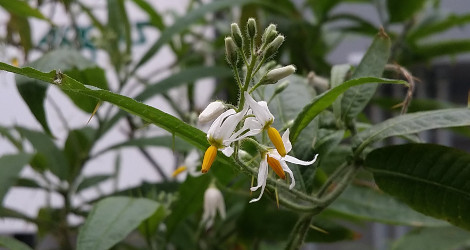Accession Data:
Solanum ensifolium Dunal
subg. Leptostemonum sect. Persicariae
- Common Name: Erubia
- Family: Solanaceae Juss.
- Synonym(s): Solanum drymophilum O.E. Schulz
- Country of Origin: Sierra de Cayey in central Puerto Rico

- Habitat: Erubia is native to evergreen forests on volcanic soils
- Description: Erubia is a spiny, evergreen shrub which can potentially grow to 18 feet in height. Sometimes, this shrub grows from a single stem, but often it branches from the base. Sharp, stiff, yellow spines, almost one-half-inch long, are located along the mid-vein of the leaves, and sometimes along the twigs. Mature shrubs have minute, whitish, star-shaped hairs on their leaves and petioles. These hairs are longer on younger shrubs and they appear on the twigs, and flowers of these younger individuals. The leaves of this shrub are alternate and lanceolate to lanceolate-oblong shaped. Its white, bisexual flowers are five-lobed and fan-shaped. The fruits are round, shiny, black berries. This shrub seems to flower and produce fruit throughout the year. Whether or not it reaches a flowering peak during a certain season is unknown, but its seed production appears to be abundant.
Only 100 to 150 plants still exist on a single, 2-acre site in the Sierra de Cayey in central Puerto Rico. This site, known as the Tetas de Cayey, is privately owned. Historically, the species may have been scattered throughout the southeastern section of the central mountains (Sierra de Cayey and Sierra de Naguabo). Although the historic range of the species is unknown, this shrub may have been locally common in sections of eastern Puerto Rico and in the western mountains. In the 196O's, one population was found in the Lares area but this population is now considered extirpated.
{Info from US Fish & Wildlife Endangered Species Website}
Recent searches have failed to locate plants in habitat in Puerto Rico, following the destruction caused by Hurricane Maria, and it is possible that Solanum ensifolium is now extinct in the wild. Three original clones from wild seed are in cultivation, two from the UConn Botanical Conservatory and one from the research collection of Lynn Bohs.
Accession Data:
- Accession # 200300321
- Source: Bryan Connolly ex Fairchild Tropical Gar
- Provenance:
Rcvd as Solanum drymophilum. Originally wild collected from Las Tetas de Cayey, Puerto Rico in an "understory of dry limestone forest". Information from Iris BG - Brian Harding at Fairchild Tropical BG, February 2020.
- Accession Date: 10-06-2003
- Bench: 1304 - NEOA: North Bench W
- Currently: active - healthy
- Qty: 2 confirmed on 07-01-2025
- Restrictions:
- IUCN Red List: Critically Endangered Species
- BGCI Limited Ex Situ Distribution - Plants do not leave building without Manager approval!
- IUCN Red List: Critically Endangered Species
Classification:
- Division: Magnoliophyta
- Class: Magnoliopsida
- SubClass: euasterid I
- Order: Solanales
- SubOrder:
- Family: Solanaceae
- SubFamily: Solanoideae
- Tribe: Solaneae
- SubTribe:
Flowering Data:
This accession has been observed in bloom on:| Year | Jan | Feb | Mar | Apr | May | Jun | Jul | Aug | Sep | Oct | Nov | Dec | ||||||||||||||||||||||||||||||||||||||||
|---|---|---|---|---|---|---|---|---|---|---|---|---|---|---|---|---|---|---|---|---|---|---|---|---|---|---|---|---|---|---|---|---|---|---|---|---|---|---|---|---|---|---|---|---|---|---|---|---|---|---|---|---|
| 2025 | ||||||||||||||||||||||||||||||||||||||||||||||||||||
| 2024 | ||||||||||||||||||||||||||||||||||||||||||||||||||||
| 2023 | ||||||||||||||||||||||||||||||||||||||||||||||||||||
| 2022 | ||||||||||||||||||||||||||||||||||||||||||||||||||||
| 2021 | ||||||||||||||||||||||||||||||||||||||||||||||||||||
| 2020 | ||||||||||||||||||||||||||||||||||||||||||||||||||||
| 2019 | ||||||||||||||||||||||||||||||||||||||||||||||||||||
| 2018 | ||||||||||||||||||||||||||||||||||||||||||||||||||||
| 2017 | ||||||||||||||||||||||||||||||||||||||||||||||||||||
| 2016 | ||||||||||||||||||||||||||||||||||||||||||||||||||||
| 2015 | ||||||||||||||||||||||||||||||||||||||||||||||||||||
| 2014 | ||||||||||||||||||||||||||||||||||||||||||||||||||||
| 2013 | ||||||||||||||||||||||||||||||||||||||||||||||||||||
| 2012 | ||||||||||||||||||||||||||||||||||||||||||||||||||||
| 2011 | ||||||||||||||||||||||||||||||||||||||||||||||||||||
| 2010 | ||||||||||||||||||||||||||||||||||||||||||||||||||||
| 2009 | ||||||||||||||||||||||||||||||||||||||||||||||||||||
| 2008 | ||||||||||||||||||||||||||||||||||||||||||||||||||||
| 2007 | ||||||||||||||||||||||||||||||||||||||||||||||||||||
| 2006 | ||||||||||||||||||||||||||||||||||||||||||||||||||||
| 2005 | ||||||||||||||||||||||||||||||||||||||||||||||||||||
| 2004 | ||||||||||||||||||||||||||||||||||||||||||||||||||||
References (internal):
- EEB Greenhouse Holdings native to: Puerto Rico
References (external):
- Strickland-Constable, Rose; Schneider, Harald; Ansell, Stephen W; Russell, Stephen J; Knapp, Sandra; Species identity in the Solanum bahamense species group (Solanaceae, Solanum subgenus Leptostemonum); Taxon, Volume 59, Number 1, February 2010 , pp. 209-226(18)
- The Plant List (2013). Version 1.1. Last accessed on Friday, May 18, 2018.
- Solanum drymophilum at IUCN Redlist. Last accessed on Friday, May 18, 2018.
- Solanum ensifolium at The Institute for Regional Conservation. Last accessed Friday, May 18, 2018.
- Graham, M.R., Kaur, N., Jones, C.S., Connolly, B. et al. A phoenix in the greenhouse: characterization and phylogenomics of complete chloroplast genomes sheds light on the putatively extinct-in-the-wild Solanum ensifolium (Solanaceae). BMC Plant Biol 25, 320 (2025). https://doi.org/10.1186/s12870-025-06338-8
data regenerated on Tue, 01 Jul 2025 11:51:19 -0400 [bcm v4.0]
Images:

Additional images for this accession:
Click on thumbnails to enlargeCurrent Accessions in the Solanaceae
Subfamily Browallioideae
Tribe Cestreae
Subfamily Nicotianoideae
Subfamily Petunioideae
Subfamily Solanoideae
Subfamily Solanoideae
Tribe Capsiceae
Subfamily Solanoideae
Tribe Datureae
Subfamily Solanoideae
Tribe Hyoscyameae
Subfamily Solanoideae
Tribe Juanulloeae
Subfamily Solanoideae
Tribe Lycieae
Subfamily Solanoideae
Tribe Physaleae
- Iochrominae: Iochroma cyaneum Royal Blue



- Iochrominae: Iochroma fuchsioides

- Withaninae: Withania riebeckii W/C

- Withaninae: Withania somnifera



Subfamily Solanoideae
Tribe Solaneae
- Jaltomata quipuscoae


- Solanum conocarpum

- Solanum conocarpum

- Solanum ensifolium


- Solanum ensifolium W/C



- Solanum seaforthianum

- Solanum wendlandii

 = indicates flowering in past 14 days
= indicates flowering in past 14 days
 = images available for this accession
= images available for this accession
 = map available for this accession
= map available for this accession
 = accession added within past 90 days
= accession added within past 90 days


